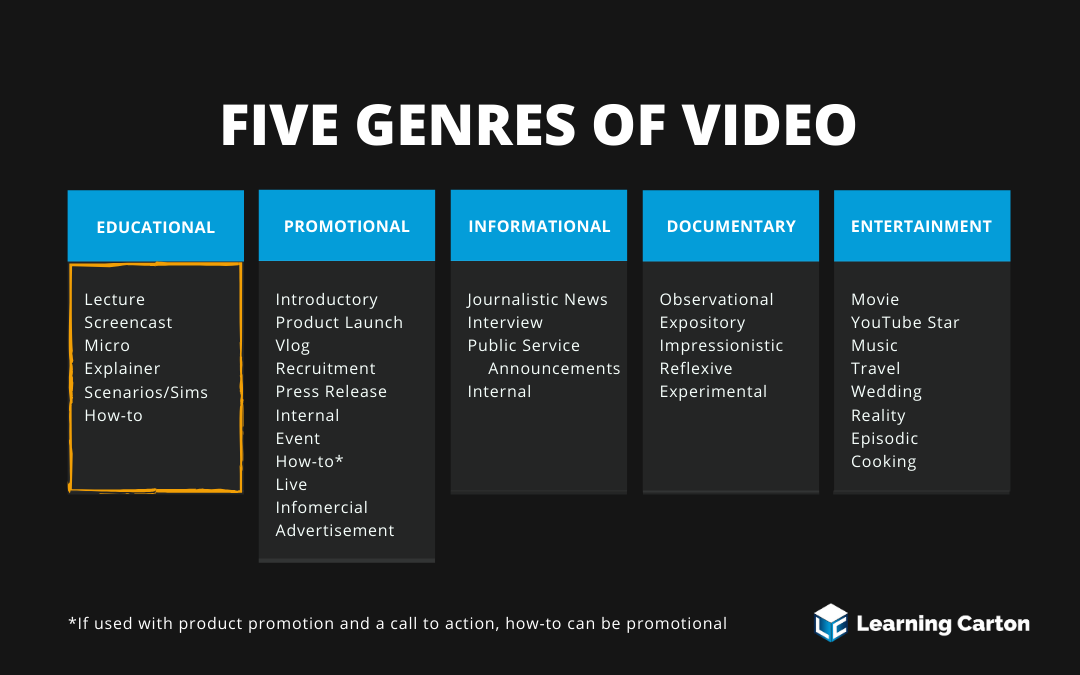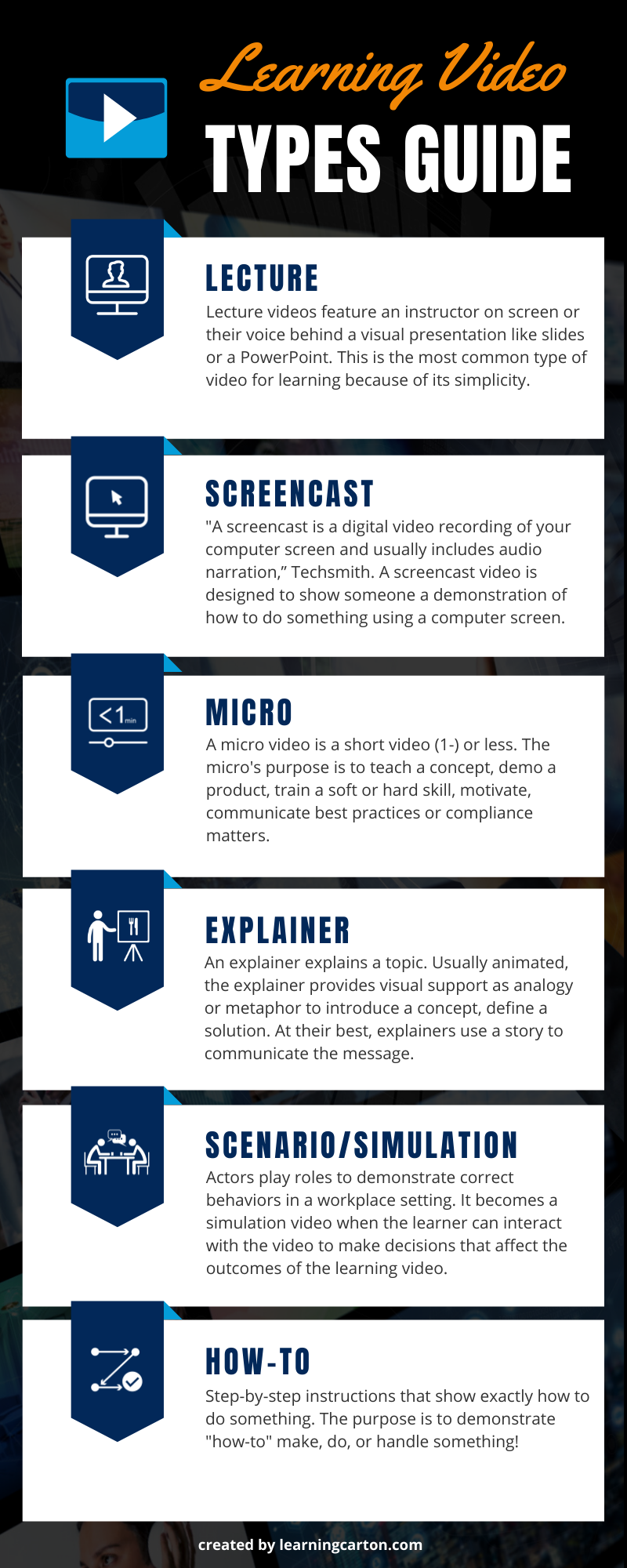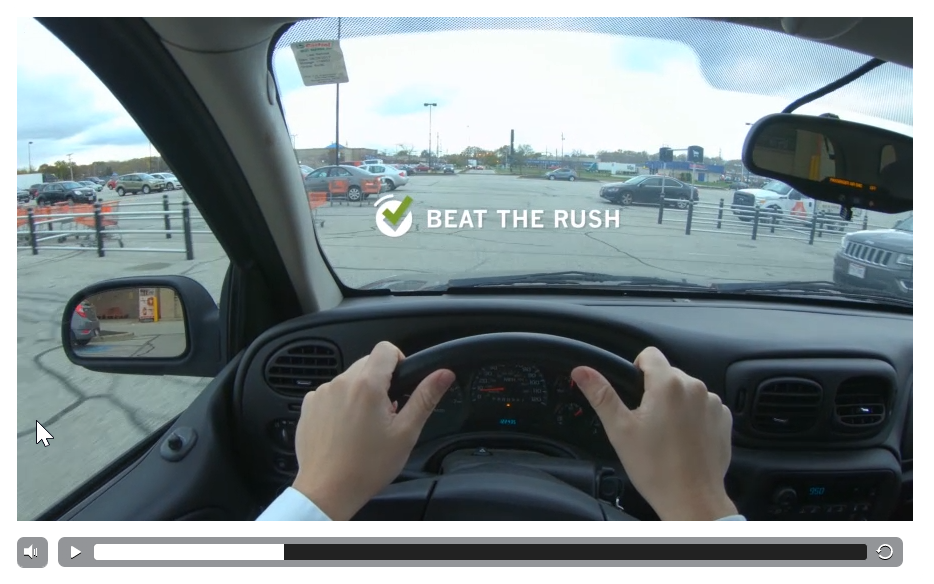“The beginning of wisdom is the definition of terms.”
― Socrates
KSB is my way of putting fun into training. KSB stands for the Knowledge, Skills, and Behaviors that should be present in every learning (training) video! I’d even go so far as to say that the promise of every learning video is delivering the KSB.
Let’s review the 6 Types of Video for Learning. I’m on a mission to help you deliver on the promise of learning video by dropping KSB into every learning video project you complete!
The 6 Types of Video for Learning follows the premise that all video fits into five genres: Educational, Promotional, Informational, Documentary, and Entertainment. Educational videos are also known as learning or instructional videos.
Are you brand new to the “video for learning” world? Consider reviewing my four-part series, Video for Learning Fundamentals:
Part 1: The Case for Video
Part 2: We Need Learning Video Production Skills
Part 3: 5 Phases of Video Production for Learning
Part 4: The Glossary of Learning Video Terms
Here’s a quick view of me chanting out KSB::
Five Genres of Video
“Tell me and I forget, teach me and I may remember, involve me and I learn.”
Benny Franklin
How we define video terms is key to understanding how to make them. Without a shared understanding – a common lexicon – we create confusion and waste time explaining instead of making solid videos that help people learn. Video for learning is always different than video for marketing or entertainment for one simple reason: all learning videos have the same purpose. This purpose is: to improve the viewers’ knowledge, skills, and/or behavior.
As of the writing of this post, all video lives in five genres: Educational, Promotional, Informational, Documentary, and Entertainment (Reel Designer).

Types of Video for Learning
The Educational genre can be broken down into six categories: Lecture, Screencast, Micro, Explainer, Scenarios/Simulations, and How-to. Let’s take a look at each one, beginning with the first of six types of video for learning, the Lecture video.

Lecture
“Information is a source of learning. But unless it is organized, processed, and available to the right people in a format for decision making, it is a burden, not a benefit.”
C. William Pollard
Other terms: Instructor-Led, Presentation, Webinar,
Lecture Capture, PowerPoint, Demonstration, Trade Show Talk, Talking head
What it is: Lecture videos feature an instructor on screen or an instructor’s voice heard narrating a visual slide deck presentation (such as PowerPoint). It is the most common type of video for learning because of its simplicity. Lecture videos are often live recordings that are rarely edited. However, the best versions of this format utilize a smooth edit between the speaker and full-screen images of the slides. This type of video is usually long (30, 60, 90 min), as it typically covers an entire lecture or presentation.
How it’s made: At the basic level, a single camera records the live presentation by the instructor or speaker. More complex lecture videos feature multiple camera angles that capture a speaker on stage at a conference or symposium (that’s a fun word to say three times) as well as the visual presentation and any other supporting material. These require further editing and, therefore, take longer to complete.
Purpose: Communicate the contents of a lesson for review by the learner at a convenient time.
Cost to Produce: 0 – $$
CMI University Lecture by Robert Rose of the Content Marketing Institute.
Screencast
“Change is the end result of all true learning.”
Leo Buscaglia
Other terms: ScreenCap, ScreenShare
What it is: According to TechSmith, maker of the popular screen recording software Camtasia, “A screencast is a digital video recording of your computer screen and usually includes audio narration.” A screencast video is designed to show someone a demonstration of how to do something using a computer screen. For example, a dear friend of mine shared that his employees make screencasts as internal training on how to perform complex financial tasks. The employees record their screen while they do complicated computations in a spreadsheet. Screencasts can also be used for learning how to use a new piece of software. Screencast videos can range from informal and rapidly produced to explainer-style videos with high production value featuring graphic animations.
How it’s made: By using a screen recording application, you capture the movements of the mouse on the screen along with images, or other video clips. Then, within the same software, you can edit the video to include annotations and text overlays to support the narration. High-quality screencasts include the use of an external microphone routed through the computer to capture narration.
Purpose: Show someone how to use software. Offer informal instruction.
Cost to Produce: 0 – $
Recommended Tools: Camtasia, Screencast-o-matic, or Screenflow (Mac only) (7 Best)

Daily Time Tracking Screencast by Zenya Learning LLC
Micro
“You don’t understand anything until you learn it more than one way.”
Marvin Minsky
Other terms: Microlearning, Vine, Story, Short Video, executive charge
What it is: A micro video is a short video (1 minute or less). Most micro videos are advertisements or marketing pieces that dominate platforms like Twitter, Instagram, Snapchat, and TikTok. Perhaps, for this reason alone, the micro video belongs in the six types of video for learning. We know that society today has a very short attention span, so these videos are the perfect amount of time to get someone to watch the whole way through. Your learning audience will be very familiar with the formula of a micro video from all the marketing they’re exposed to, so use it to your advantage!
The basic formula of micro videos is Hook-Prep-Message-Review-Next. The “Hook” grabs the learner’s attention. “Prep” is where the video taps the prior knowledge of the learner to energize the brain, which enables the learning of the new concept. The “Message” is where the content is delivered, usually as a narrative explanation or visual depiction. The “Review” serves as a recap of the previous three parts of the formula. Finally, the “Next” is where you show the learner what’s to come. An executive issuing an internal message to the rest of the company can be an effective use of the Micro video, encouraging retention of information and inspiring motivation to act on the message (aka behavioral change).

How it’s made: On the basic end, you can use point-and-shoot recording with a mobile phone. At the high end (in both price and complexity), you can hire a video production company to plan, record, and edit the micro video.
Purpose: Teach a concept, demo a product, train a soft or hard skill, motivate, communicate best practices or compliance information.
Cost to Produce: 0 – $$$
[Your micro-video example could be featured here – email a link to chris@learningcarton.com]
Explainer
“Education without application is just entertainment.”
Tim Sanders
Other terms: Product Knowledge, Product Demo, Whiteboard, Animated Icons
What it is: An explainer does exactly what its name implies: it explains a topic. Usually, they are animated using two-dimensional shapes and characters. Storytelling is at the heart of the explainer. Like the micro video, this type of video is common in marketing and advertising. From a learning video perspective, the explainer is the perfect way to visually depict a complicated process or demonstrate how someone should act in a workplace setting. The structure typically follows the tell-show-tell method of demonstration. Most explainers begin the story with a problem (tell). Next, the explainer video offers a solution in the form of a company product or business practice (show). Finally, the video ends with an explanation of the reasons why the solution is the best course of action (tell).
How it’s made: Most explainers are animated videos. Some feature a mix of real people (live-action) with animated graphics. They can be made using online platforms Vyond, Powtoon, or Animaker or by purchasing the services of a video production company that specializes in explainers.
Purpose: Explain a topic using visual support, introduce a concept, define a solution, tell a story.
Cost to Produce: $$-$$$$

Redgrave Education & Training Inc. Explainer by Learning Carton
Scenarios & Simulations
“An organization’s ability to learn, and translate that learning into action rapidly is the ultimate competitive advantage.”
Jack Welch
What it is: A scenario video is where actors play roles to demonstrate correct behaviors in the workplace. Modeling proper behavior is the only kind of scenario video you should create. Showing what “not to do” is the wrong approach, even if you use humor. From birth, we are observational learners. If we are shown improper behavior, someone will try to replicate the bad behavior. Model the behavior you want to teach and explain why!
In a simulation video, actors also play out roles in a workplace, and the learner interacts with the video to make the proper choices. A well-known example is a sexual harassment training video that employees are required to watch annually. Think of the scenario as the instruction you should show the learner and the simulation as a way to evaluate if they comprehended the knowledge in the scenario. Simulation videos can also be a point-of-view (POV) experience where the learner demonstrates their knowledge of a sales process.

Interactive Sales Simulation by Cinecraft Productions
How it’s made: These are some of the most complex types of video for learning. To truly make scenario and simulation properly, I urge you to budget and plan for the services of a professional video production company. In a former role as production manager, I helped numerous companies make behavior-changing scenarios and simulations. Typically, there are no less than 10 skilled professionals involved in making this type of video.
Purpose: Soft-skill training (call center, selling skills, customer service), Hard-skill training (manufacturing a product, construction practices, accounting tasks, software mastery)
Cost to Produce: $$$$
How-to
“The ability to speak exactly is intimately related to the ability to know exactly.”
Wendell Berry
Other terms: tutorial, safety
What it is: The How-to video features step-by-step instructions that show exactly how to do something. The How-To video is incredibly popular. I’m sure you can think of something around your house you have fixed after watching a How-to video. The power of these videos lies in the use of behavior modeling. In other words, since you can see and hear how to complete a task, you are then able to do it yourself.
The linear, step-by-step structure makes it easy for learners to tackle everything from applying makeup to managing complex financial situations. The predictable formula encourages people to pause the instruction, rewind, or advance through steps as needed. It feels good to have that kind of control over learning and be able to digest the information at the pace with which the learner is most comfortable.
How it’s made: On the basic end, you can use point-and-shoot recording with a mobile phone and then edit the steps together using the editing software of your choice. At the high end (in terms of price and complexity), you can hire a video production company to plan, record, and edit the how-to video.
Purpose: Teach “how-to” make, do, or handle just about anything.
Cost to Produce: $-$$$$

Peter McKinnon How-to – 5 ways to INSTANTLY make BETTER VIDEOS! by Peter McKinnon
Summary
As you become more familiar with each of the six types of video for learning, remember the purpose of video for learning: to improve knowledge, skills, and/or behavior. Techniques and methods used in the other four genres of non-learning video do find their way into educational video, and that is okay. But, if the purpose of the video is to improve knowledge, skills, and behavior then the video is educational. Remember, the type of video you choose to make for instructional purposes should always tie back to the learning objectives derived from your needs analysis. And, of course, the learning objectives should support your business purpose. No matter which type of video you choose to make, you can ground your content and delivery in what will best support the KSB you hope to see in your people. If you can manage this with every learning video, you will be a true learning video master, and a commander of the KSB.
Subscribe now for more helpful content
How do you use the six types of learning video to support the KSB? Which video type do you use the most?
If you liked what you read, and would like to join the conversation, please consider subscribing to my newsletter to receive free learning resources delivered to your inbox every two weeks.
THE END




